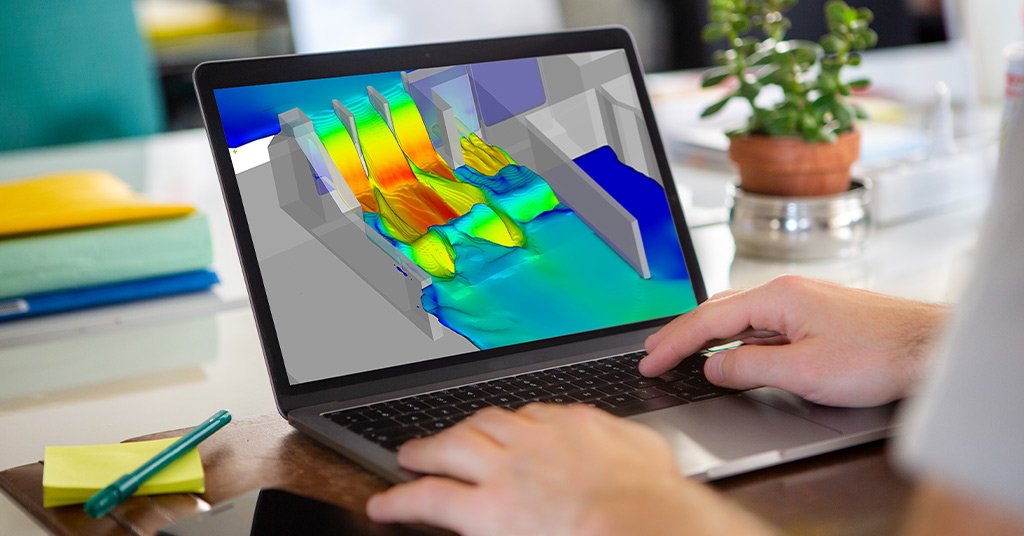CFD analysis services have been established to be a reliable measure across industries. They have helped diverse mechanical industry sectors, such as aerospace, automotive, architecture, HVAC, power and energy generation, and many others.
Primarily, CFD analysis services play a key role in analyzing and predicting problems and their causes and optimizing their designs to operate effectively.
In a water treatment plant, proper flow and distribution of water are critical. Ineffective water treatment and many other failures can occur if inadequate and unequal water distribution.
This article will guide you through the detailed application of CFD consulting in the water treatment plant and how it can improve water distribution channels. But let’s briefly understand the basics of CFD.
What Is CFD: A Brief Explainer
Computational Fluid Dynamics (CFD) is a method of analyzing fluid flow, predicting fluid behavior inside a system, and optimizing the systems to work effectively.
CFD is a simulation-based engineering technique that provides solutions using fluid mechanic equations, namely, conservations of mass, momentum, and energy, which describe fluid flow and fluid properties, such as pressure, velocity, viscosity, and other properties of fluids.
Depending on the requirements and needs of the analysis, any of these CFD simulation programs are used: ANSYS fluent, OpenFOAM, COMSOLMultiphysics, STAR-CCM+, etc.
CFD Analysis Services for Water Distribution Channels

In water treatment plants, the water distribution channel is the interconnected network of pipes and other hydraulic systems, such as pumps, regulators, tanks, etc., used to deliver drinkable water to consumers. It is the backbone of water treatment plants.
However, it often experiences multiple problems with distribution channels, such as contamination, energy loss, decreased efficiency, etc.
That is where CFD analysis services can be instrumental in simulating water distribution channels to analyze, evaluate, and predict the behavior of water and its flow inside the channels. This leads to designing suitable strategies to optimize water distribution channels.
Improving Water Distribution: Scope of CFD Analysis Services
CFD simulation of water distribution channels can mimic almost every phenomenon that takes place inside water distribution channels. For example:
1. Flow Simulation
CFD Simulation of water distribution channels can be used to understand the behavior of water flow inside channels and its properties, such as velocity, pressure, turbulence, mixing, etc.
Flow simulation also involves velocity and pressure distribution analysis, which can identify the areas where the flow is slow or high and where the pressure surges or drops.
Turbulence analysis can provide information about the turbulence of the water flow at a particular area inside channels. The higher the turbulence, the more energy losses.
2. Mixing and homogenization
Such studies in the simulation can show how mixing and homogenization occur inside channels. Subsequently, experts can identify areas where mixing and homogenization are poor, which can cause the bad quality of water supply.
Hence, flow simulation can be used to optimize the design of the areas where these problems are occurring and improve the overall efficiency of plants.
3. Hydraulic Design Analysis
In water treatment plants’ distribution channels, hydraulic components, such as pumps, regulators, valves, etc., are integral and play a crucial role in the proper water supply. The proper functioning of these hydraulic components is crucial for plants’ efficient and effective operation.
CFD analysis services involving these hydraulic components in the simulation allow experts to study the flow of water through or by them under different conditions and identify the areas where improvement can be made.
It also allows engineers and experts to inspect various designs quickly, which can be informative when considering complex systems.
4. Containment Transport Simulation
In water treatment plants, water is treated to remove contaminants, and some residual containment may remain in the water and pose risks to public health and the environment. These containments must not accumulate in the distribution channels of water treatment plants.
CFD analysis services in the simulation can be used to evaluate water flow and containment transport in channels under different conditions, such as flow rates, channel configurations, and containment concentrations.
The simulation results provide a strategy, such as modifying the design of the channels to improve the flow rate and improving the mixing and homogenization of fluid flow to reduce the risks of contamination.
5. Solute Transport Simulation
Solute (dissolved substances) are used in the water for coagulation, PH level improvement, disinfection, etc. Proper transportation and solution of solute and water are imperative to good quality of water.
CFD analysis services can analyze and predict the movement of these dissolved substances in water distribution channels in water treatment plants. By defining the problems, such as areas where solute may be accumulating, and contamination is high in the simulation analysis, CFD can provide information about the movement of the solute through distribution channels.
6. Energy Loss Analysis
Energy Loss is one of the main concerns with distribution channels in water treatment plants because it increases the operating cost of water treatment plants.
In energy loss analysis in the simulation, engineers and experts can study the areas of water distribution channels where flow is slow or turbulent and energy losses by them.
CFD analysis can evaluate the areas where energy loss occurs and help develop a strategy to optimize and improve the design distribution channels with minimal energy losses.
Key Takeaways
CFD analysis services are an excellent option for optimizing water distribution channels as they can identify the causes of problems, such as energy loss, contaminations, solute transport, pressure surges, drops, mixing and homogenization, etc.
Additionally, precise insights help strategize for improving and optimizing water distribution channels for better operation and efficiency.
However, CFD analysis of water distribution channels requires specialized CFD computer programs, engineers, and experts to perform the analysis task to get exceptional results.
We at Mechartes provide extraordinary CFD simulation services for a variety of industries, including water treatment plants. Our team consists of highly skilled engineers and CFD experts who can help design better water distribution channels and tackle any ongoing issues in the system.
Talk to us to learn more!


 Share
Share  facebook
facebook